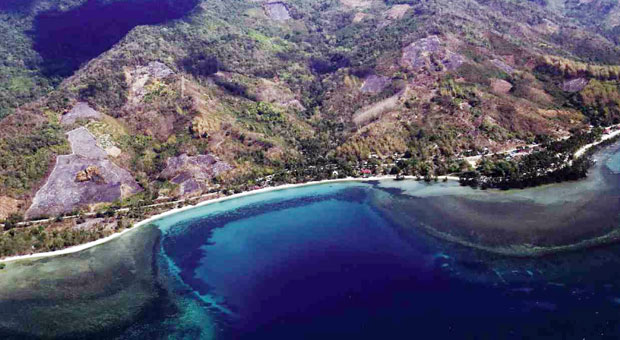
BILL GATES WAS HERE The practice of ‘kaingin’ (swidden or slash-and-burn farming) is destroying swaths of forestland along the national highway in Puerto Princesa City and other areas of Palawan province, once dubbed the country’s “last frontier” for its lush forest cover. Still, Palawan remains the country’s only province with a forest cover close to half of its entire landmass. JONAH VAN BEIJNEN / CONTRIBUTOR
PUERTO PRINCESA CITY—Summer in Palawan is not all beach and white sand. For many poor families living on its forest fringes, it is a season for burning the wilderness to plant the crops that would tide them over in the coming months.
For the environmentalists, it is a time to fret over how the country’s so-called “last frontier” is rapidly losing its virgin forests to all kinds of destructive activities.
An aerial survey of mainland Palawan conducted by some nongovernment organizations last week showed “an alarming increase in the incidence of slash-and-burn farming,” as poor families take to the forests to clear areas for planting.
Locally known as “kaingin,” it is practiced in anticipation of the rains after summer and to prepare the soil for planting.
“Every year it (kaingin) gets worse,” said lawyer Robert Chan, the head of the Palawan NGO Network Inc. (PNNI).
Ugly scars
The group noted the high incidence of kaingin-burning in the southern Palawan municipalities of Aborlan, Rizal and Quezon and in the northern towns of Roxas and Taytay. Parts of the forests of Puerto Princesa City, along the western coast and even in the areas by the national highway, bore the ugly scars of freshly burned patches.
“It looks like the worst places are Aborlan and Roxas,” observed Jonah van Beijnen, the head of the Center for Sustainability, a nonprofit organization working for sustainable development in Palawan. The group is campaigning to have the mountain called Cleopatra’s Needle in central Palawan declared a protected area.
The extent of the cleared areas vary, averaging the size of four basketball courts each, and their locations are generally on mountain ridges, said Beijnen, a biologist.
He noted that while the tribes of Palawan practice traditional slash-and-burn farming “in a more sustainable version,” Palawan’s high rate of in-migration has also triggered destructive farming activities by settlers and immigrants.
Palm oil, rubber plantations
In some places of southern Palawan, forest burning has been linked to the proliferation of palm oil and rubber plantations, the center said.
“By now, the main target of slash-and-burn activities is the clearing of primary forests for development,” Beijnen said.
The survey also showed large tracts of areas that used to be forests taken over by palm oil plantations, particularly in the municipalities of Sofronio Española and Brooke’s Point.
Intervention strategy
Palawan Gov. Jose Alvarez, who lent his private plane for the aerial survey, admits that kaingin has become a growing problem in the countryside. He called on all government and nongovernment agencies to “work together” and put in place a comprehensive intervention strategy.
“Enforcing the law alone will not solve it. We need to join efforts to reduce poverty, make livelihood available to the poor farmer and undertake reforestation with the support of all agencies,” Alvarez said.
He proposed the convening of a “forest conservation task force” that will undertake a 10-year plan to arrest the problem of slash-and-burn farming and the resulting environmental destruction.
Less virgin forest
Palawan still boasts of being the only province in the country with a forest cover close to half of its entire land mass.
“We have about 666,338 hectares of forest, or about 46 percent, plus 58,000 hectares of mangroves,” said Alex Marcaida, a spokesperson for the Palawan Council for Sustainable Development.
Beijnen said, however, that the actual old growth, or what is called virgin forest, “may be significantly less”. He said the official provincial maps need to be properly validated on the ground.
He also noted that in many places, such as Rizal, the destructive nature of slash-and-burn farming poses a more serious threat to the environment.
“The town of Rizal contains some of the oldest, most diverse forests in Palawan, with high trees measuring up to 6 to 70 meters, by far the tallest trees in the province,” he said.
The Center for Sustainability also noted the widespread destruction of mangrove forests along the Palawan mainland’s coastal areas, where old-growth mangroves are either debarked for the illegal tanbark trade or converted into fishponds.
RELATED STORIES
Fresh water, life flow for Palaw-an tribe
Palawan is ‘top island in the world’
‘Hot’ logs seized from Palawan island-resort